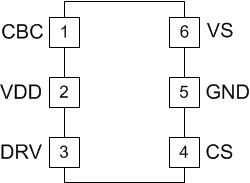SLUAA92 November 2020 UCC28700-Q1
4 Pin Failure Mode Analysis (Pin FMA)
This section provides a Failure Mode Analysis (FMA) for the pins of the UCC28700-Q1. The failure modes covered in this document include the typical pin-by-pin failure scenarios:
- Pin short-circuited to Ground (see Table 4-2)
- Pin open-circuited (see Table 4-3)
- Pin short-circuited to an adjacent pin (see Table 4-4)
- Pin short-circuited to supply (see Table 4-5)
Table 4-2 through Table 4-5 also indicate how these pin conditions can affect the device as per the failure effects classification in Table 4-1.
| Class | Failure Effects |
|---|---|
| A | Potential device damage that affects functionality |
| B | No device damage, but loss of functionality |
| C | No device damage, but performance degradation |
| D | No device damage, no impact to functionality or performance |
Figure 4-1 shows the UCC28700-Q1 pin diagram. For a detailed description of the device pins please refer to the Pin Configuration and Functions section in the UCC28700-Q1 data sheet.
 Figure 4-1 Pin Diagram
Figure 4-1 Pin DiagramFollowing are the assumptions of use and the device configuration assumed for the pin FMA in this section:
- THe UCC28700-Q1 is connected according to the UCC28700-Q1 datasheet Figure 17, typical application circuit
| Pin Name | Pin No. | Description of Potential Failure Effect(s) | Failure Effect Class |
|---|---|---|---|
| CBC | 1 | Cable compensation will be set at its highest value. | C |
| VDD | 2 | No positive supply applied to device. Device is non-functional. | B |
| DRV | 3 | DRV remains low. The output of the flyback converter remains at zero. | B |
| CS | 4 | When CS pin is shorted to ground before IC operation, CS pin short protection. The output of the flyback converter remains at zero. | B |
| When CS pin is shorted to ground after IC operation, DRV pin remains high. Potential power stage damage and it might cause IC damange. | A | ||
| GND | 5 | No effect | D |
| VS | 6 | IC reamins in input under voltage protection mode. The output of the flyback converter remains at zero. | B |
| Pin Name | Pin No. | Description of Potential Failure Effect(s) | Failure Effect Class |
|---|---|---|---|
| CBC | 1 | Cable Compensation is Reduce to It's Minimal Value. | C |
| VDD | 2 | No positive supply applied to device. Device is non-functional. | B |
| DRV | 3 | The output of the Flyback converter remains at zero. | B |
| CS | 4 | CS pin open protection. The output of the Flyback converter remains at zero. | B |
| GND | 5 | Device damage | A |
| VS | 6 | IC reamins in input under voltage protection mode. The output of the Flyback converter remains at zero. | B |
| Pin Name | Pin No. | Shorted to | Description of Potential Failure Effect(s) | Failure Effect Class |
|---|---|---|---|---|
| CBC | 1 | VDD | DRV remains low. Possible IC damage. | A |
| VDD | 2 | DRV | DRV remians high. Possible IC damange and Flyback siwtch damage. | A |
| DRV | 3 | N/A | ||
| CS | 4 | GND | When CS pin is shorted to ground before IC operation, CS pin short protection. The output of the flyback converter remains at zero. | B |
| When CS pin is shorted to ground after IC operation, DRV pin remains high. Potential power stage damage and it might cause IC damange. | A | |||
| GND | 5 | VS | IC reamins in input under voltage protection mode. The output of the flyback converter remains at zero. | B |
| VS | 6 | N/A |
| Pin Name | Pin No. | Description of Potential Failure Effect(s) | Failure Effect Class |
|---|---|---|---|
| CBC | 1 | DRV remains low. Possible IC damage. | A |
| VDD | 2 | No effect | D |
| DRV | 3 | DRV remians high. Possible IC damange and Flyback siwtch damage. | A |
| CS | 4 | DRV remains low. Possible IC damage. | A |
| GND | 5 | No positive supply applied to device. Device is non-functional. | B |
| VS | 6 | IC damage. DRV remains low. | A |